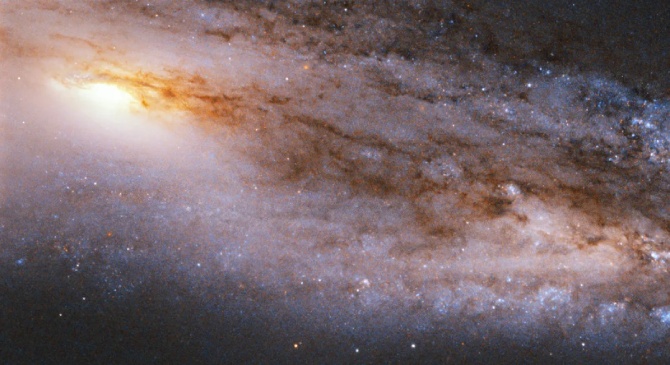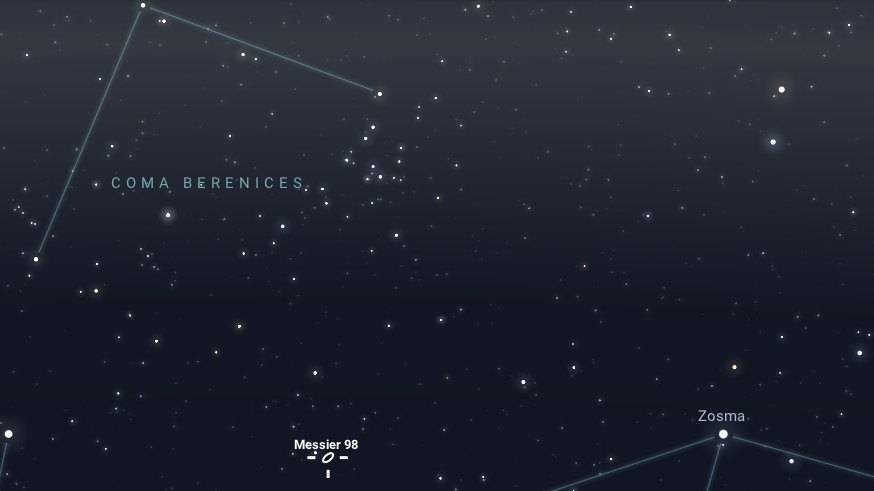M98, also known as NGC 4254, was discovered by the French astronomer Pierre Méchain on March 15, 1781. Charles Messier included it in his famous catalog of nebulae and star clusters shortly afterward. M98 is classified as an intermediate spiral galaxy (SAB(rs)ab), which means it has features between those of barred spiral and unbarred spiral galaxies, with moderately wound arms and a slight bar structure.
Physical Characteristics
M98 is located approximately 44 million light-years from Earth in the constellation Coma Berenices. The galaxy spans about 160,000 light-years, making it larger than our Milky Way. It has an apparent magnitude of 10.1, making it faint and requiring a telescope for observation.
The galaxy’s structure is notable for its prominent central bulge and tightly wound spiral arms, which contain numerous star-forming regions. The galaxy also has significant amounts of interstellar dust and gas, which contribute to its dark appearance and slightly irregular shape.
Star Formation and Composition
M98 is an active galaxy with ongoing star formation, particularly in its spiral arms. These regions are home to young, hot stars and numerous H II regions, which are clouds of ionized hydrogen gas. The presence of interstellar dust and gas fuels this star formation activity.
Infrared observations of the galaxy reveal a warm dust component, indicative of active star-forming regions. The galaxy also emits X-rays, suggesting the presence of high-energy processes such as supernova remnants and binary star systems.

M98 in the Virgo Cluster
M98 is a member of the Virgo Cluster, a massive cluster of galaxies centered in the constellation Virgo. This cluster is part of the larger Virgo Supercluster, which includes the Local Group of galaxies (home to the Milky Way and Andromeda). M98’s membership in the Virgo Cluster means it is influenced by the gravitational interactions and dynamics of the cluster, which can affect its structure and star formation activity.
Research and Scientific Importance
M98 is an important object for studying the dynamics of spiral galaxies and the effects of environment on galaxy evolution. Its intermediate classification provides insights into the processes that shape galaxies over time. Observations across various wavelengths, from radio to X-ray, help astronomers study the distribution of stars, gas, and dark matter within the galaxy.
The galaxy’s membership in the Virgo Cluster also makes it valuable for understanding the interactions between galaxies in a dense environment. These interactions can lead to tidal forces that distort the shapes of galaxies and trigger star formation.
Observation
For amateur astronomers, M98 is best observed during the spring months, from March through May, when Coma Berenices is prominent in the night sky. Look for the constellation Leo, with its recognizable backward question mark (the Sickle) and Denebola at the eastern end of the constellation. From Denebola, move your telescope or binoculars approximately 6 degrees to the west (slightly to the left if facing south). Use a star chart to help you navigate from Denebola to M98.

A telescope with a diameter of at least 6 inches (15 cm) is recommended to view M98, though larger telescopes will reveal more detail. Under dark skies and with good seeing conditions, M98 can be seen as a faint, elongated patch of light. Its elongated shape is due to its significant inclination angle, which means we are viewing the galaxy almost edge-on. A 10-inch telescope should start to reveal some of M98’s spiral structure and hints of dust lanes, while a 12-inch telescope will provide a better chance of seeing these features more clearly.



